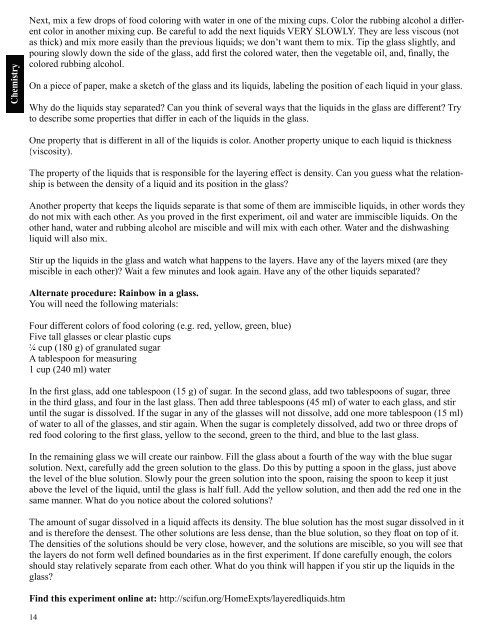ScienceMakers Toolkit Manual - The History Makers
ScienceMakers Toolkit Manual - The History Makers
ScienceMakers Toolkit Manual - The History Makers
You also want an ePaper? Increase the reach of your titles
YUMPU automatically turns print PDFs into web optimized ePapers that Google loves.
Chemistry<br />
Next, mix a few drops of food coloring with water in one of the mixing cups. Color the rubbing alcohol a different<br />
color in another mixing cup. Be careful to add the next liquids VERY SLOWLY. <strong>The</strong>y are less viscous (not<br />
as thick) and mix more easily than the previous liquids; we don’t want them to mix. Tip the glass slightly, and<br />
pouring slowly down the side of the glass, add fi rst the colored water, then the vegetable oil, and, fi nally, the<br />
colored rubbing alcohol.<br />
On a piece of paper, make a sketch of the glass and its liquids, labeling the position of each liquid in your glass.<br />
Why do the liquids stay separated? Can you think of several ways that the liquids in the glass are different? Try<br />
to describe some properties that differ in each of the liquids in the glass.<br />
One property that is different in all of the liquids is color. Another property unique to each liquid is thickness<br />
(viscosity).<br />
<strong>The</strong> property of the liquids that is responsible for the layering effect is density. Can you guess what the relationship<br />
is between the density of a liquid and its position in the glass?<br />
Another property that keeps the liquids separate is that some of them are immiscible liquids, in other words they<br />
do not mix with each other. As you proved in the fi rst experiment, oil and water are immiscible liquids. On the<br />
other hand, water and rubbing alcohol are miscible and will mix with each other. Water and the dishwashing<br />
liquid will also mix.<br />
Stir up the liquids in the glass and watch what happens to the layers. Have any of the layers mixed (are they<br />
miscible in each other)? Wait a few minutes and look again. Have any of the other liquids separated?<br />
Alternate procedure: Rainbow in a glass.<br />
You will need the following materials:<br />
Four different colors of food coloring (e.g. red, yellow, green, blue)<br />
Five tall glasses or clear plastic cups<br />
3 ⁄ ⁄4 ⁄ 4 cup (180 g) of granulated sugar<br />
A tablespoon for measuring<br />
1 cup (240 ml) water<br />
In the fi rst glass, add one tablespoon (15 g) of sugar. In the second glass, add two tablespoons of sugar, three<br />
in the third glass, and four in the last glass. <strong>The</strong>n add three tablespoons (45 ml) of water to each glass, and stir<br />
until the sugar is dissolved. If the sugar in any of the glasses will not dissolve, add one more tablespoon (15 ml)<br />
of water to all of the glasses, and stir again. When the sugar is completely dissolved, add two or three drops of<br />
red food coloring to the fi rst glass, yellow to the second, green to the third, and blue to the last glass.<br />
In the remaining glass we will create our rainbow. Fill the glass about a fourth of the way with the blue sugar<br />
solution. Next, carefully add the green solution to the glass. Do this by putting a spoon in the glass, just above<br />
the level of the blue solution. Slowly pour the green solution into the spoon, raising the spoon to keep it just<br />
above the level of the liquid, until the glass is half full. Add the yellow solution, and then add the red one in the<br />
same manner. What do you notice about the colored solutions?<br />
<strong>The</strong> amount of sugar dissolved in a liquid affects its density. <strong>The</strong> blue solution has the most sugar dissolved in it<br />
and is therefore the densest. <strong>The</strong> other solutions are less dense, than the blue solution, so they fl oat on top of it.<br />
<strong>The</strong> densities of the solutions should be very close, however, and the solutions are miscible, so you will see that<br />
the layers do not form well defi ned boundaries as in the fi rst experiment. If done carefully enough, the colors<br />
should stay relatively separate from each other. What do you think will happen if you stir up the liquids in the<br />
glass?<br />
Find this experiment online at: http://scifun.org/HomeExpts/layeredliquids.htm<br />
14










